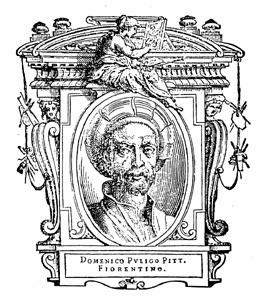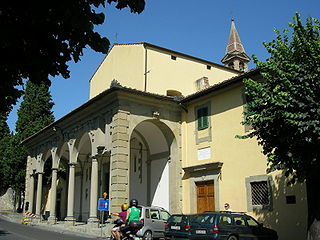
Mariotto di Bindo di Biagio Albertinelli was an Italian Renaissance painter active in Florence. He was a close friend and collaborator of Fra Bartolomeo.

Filippino Lippi was an Italian painter working in Florence, Italy during the later years of the Early Renaissance and first few years of the High Renaissance.

Andrea del Verrocchio, born Andrea di Michele di Francesco de' Cioni, was a sculptor, Italian painter and goldsmith who was a master of an important workshop in Florence.

Pinturicchio, or Pintoricchio, also known as Benetto di Biagio or Sordicchio, was an Italian painter during the Renaissance. He acquired his nickname because of his small stature and he used it to sign some of his artworks that were created during the fifteenth and sixteenth centuries.

Pietro Perugino, born Pietro Vannucci, was an Italian Renaissance painter of the Umbrian school, who developed some of the qualities that found classic expression in the High Renaissance. Raphael was his most famous pupil.

Lorenzo di Credi was an Italian Renaissance painter and sculptor best known for his paintings of religious subjects. He is most famous for having worked in the studio of Andrea del Verrocchio at the same time as the young Leonardo da Vinci.

The Marriage of the Virgin is a painting by the Italian Renaissance master Perugino, although it is now sometimes attributed to his pupil Lo Spagna. It depicts the marriage between Joseph and Mary, and is now in the Musée des Beaux-Arts of Caen, France. Initially commissioned to Pinturicchio for the recently completed cathedral of Perugia, Perugino took over the commission and finished the work around 1500–1504, probably after several periods of stasis.

The Baptism of Christ is an oil-on-panel painting finished around 1475 in the studio of the Italian Renaissance painter Andrea del Verrocchio and generally ascribed to him and his pupil Leonardo da Vinci. Some art historians discern the hands of other members of Verrocchio's workshop in the painting as well.

Portrait of Elisabetta Gonzaga is an oil on wood painting attributed to the Italian Renaissance artist Raphael, completed c. 1504–1505, and today housed in the Uffizi Gallery, Florence.

Domenico Puligo (1492–1527) was an Italian painter of the Renaissance, active in Florence. His real name was Domenico di Bartolomeo Ubaldini.

Andrea di Aloigi, called L'Ingegno, was an Italian Renaissance painter.

The Convent of San Domenico is a Dominican convent in Fiesole, Italy, situated between the hill of Fiesole and the suburbs of Florence. It was founded in 1406 and completed in 1435 on the initiative of Giovanni Dominici and the bishop of Fiesole, Jacopo Altoviti, both of them friars at the Basilica of Santa Maria Novella in Florence.

The Adoration of the Shepherds is a painting by the Italian Renaissance painter Lorenzo di Credi, dating to about 1510. It is displayed in the Uffizi Gallery of Florence.

The Madonna and Child Enthroned with Saints John the Baptist and Sebastian is a painting by the Italian Renaissance artist Pietro Perugino, executed in 1493 and housed in the Uffizi Gallery, Florence.

The Vallombrosa Altarpiece is a painting by the Italian Renaissance painter Pietro Perugino, dating to 1500–01. It is housed in the Accademia Gallery of Florence, Italy.

The Portrait of Lorenzo di Credi is a painting by the Italian Renaissance artist Perugino, dating to around 1504 and housed in the National Gallery of Art, Washington, DC, United States.

The Portrait of Francesco delle Opere is a painting by the Italian Renaissance artist Perugino, dating to 1494 and housed in the Uffizi Gallery, Florence.

The Piazza Madonna is a tempera on panel painting, dating to 1474-1486 and held in Pistoia Cathedral.

Portrait of a Boy is a 1495 oil on panel portrait, now in the Uffizi in Florence. In the past it has been attributed to Lorenzo di Credi, Viti, Jacopo Francia, Raphael and others, but Giovanni Morelli's reattribution of it to Perugino is now widely accepted. Although the lack of a landscape background is unusual for this painter, the style is typical of his portrait technique.

Portrait of a Woman is a 1512 oil on panel painting by Sebastiano del Piombo, dated by the artist and now in the Uffizi in Florence.



















